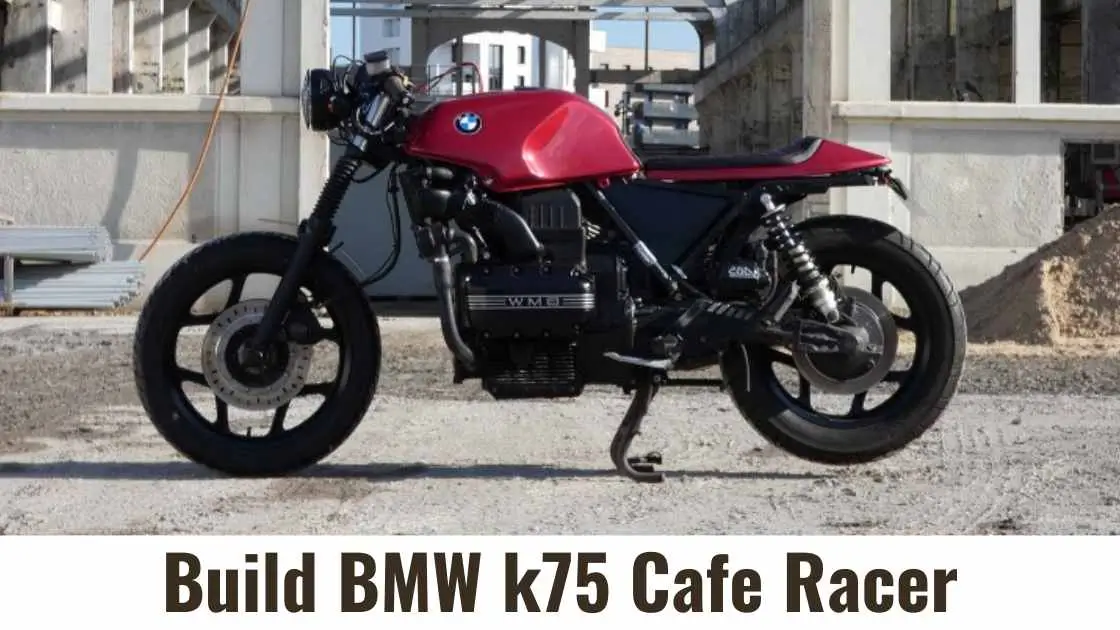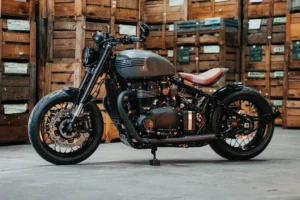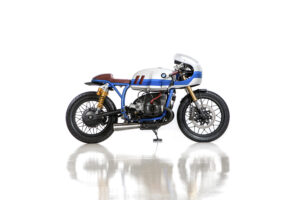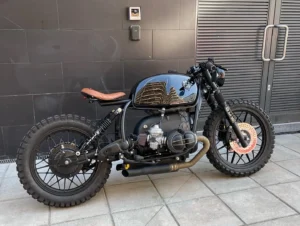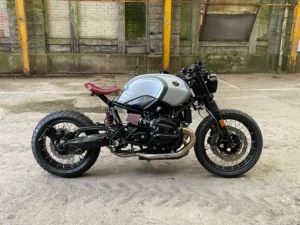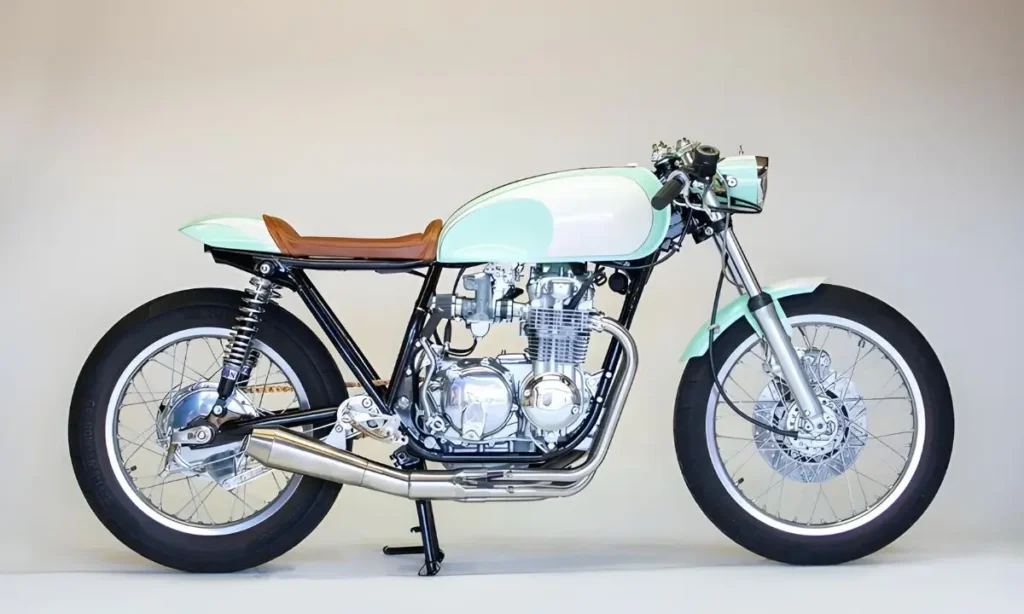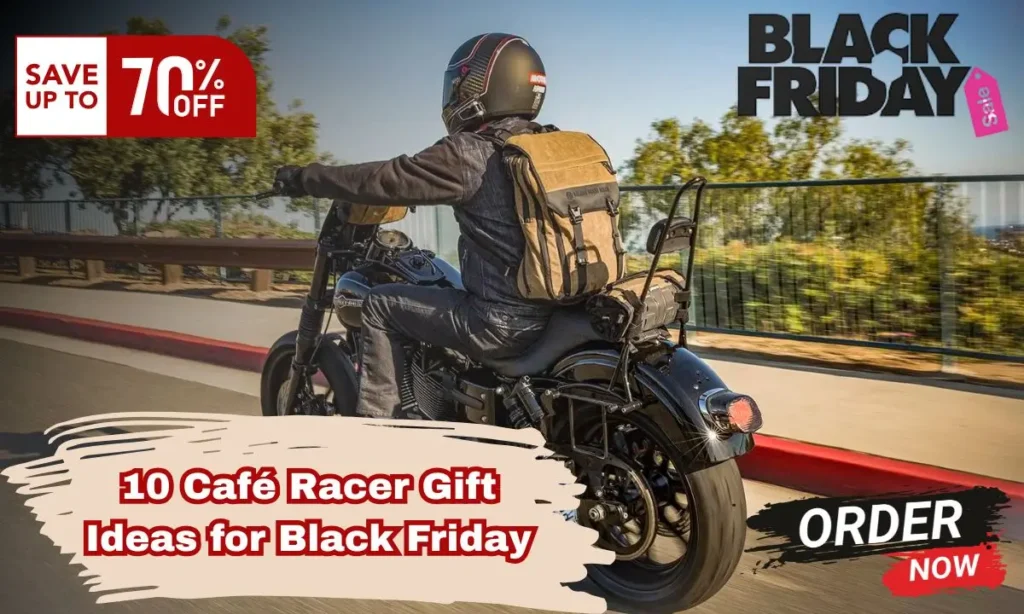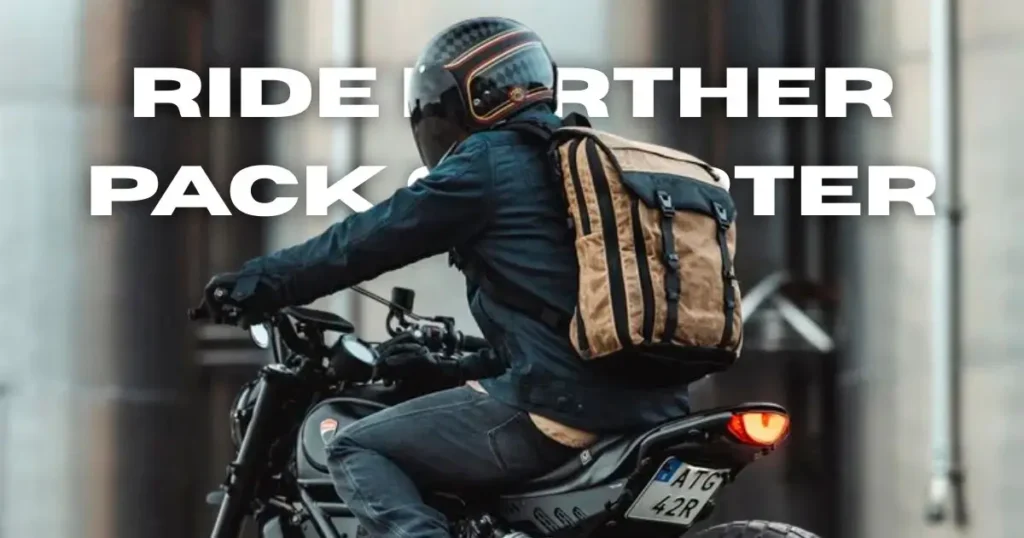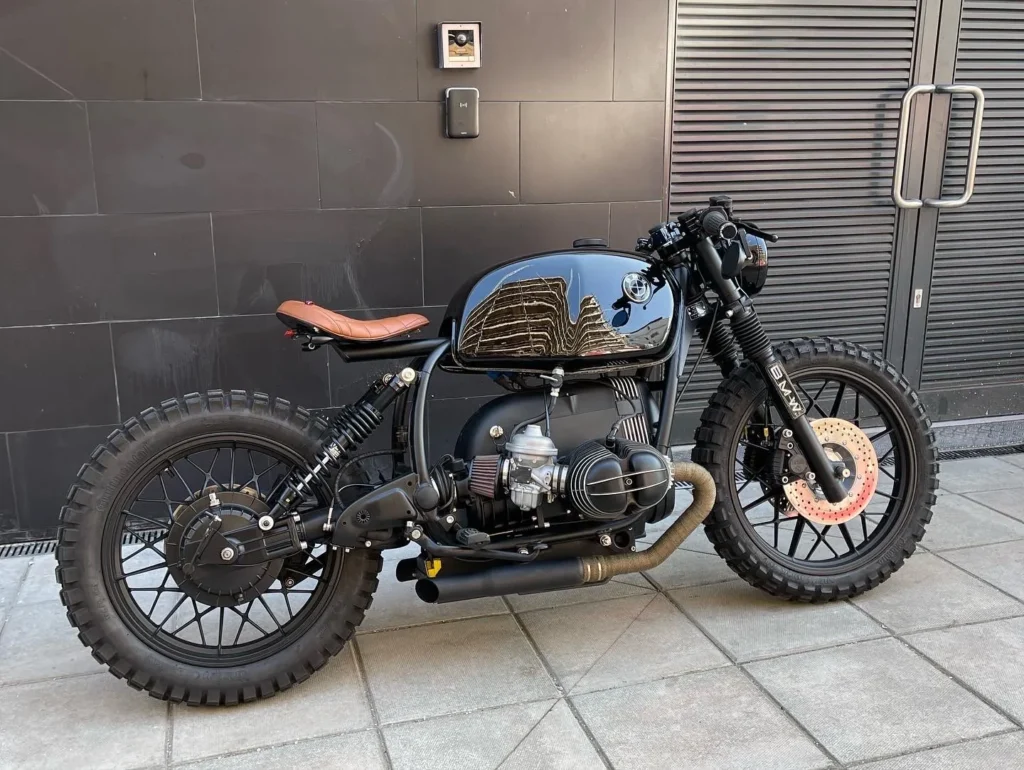Table of Contents
ToggleBuilding a BMW K75 cafe racer is more than just making a cool bike. It’s about fun, challenge, and turning the bike into something that’s yours. So why the K75? It’s called the “Flying Brick” because of its strong engine. The K75 is reliable and doesn’t cost a lot, making it a great choice.
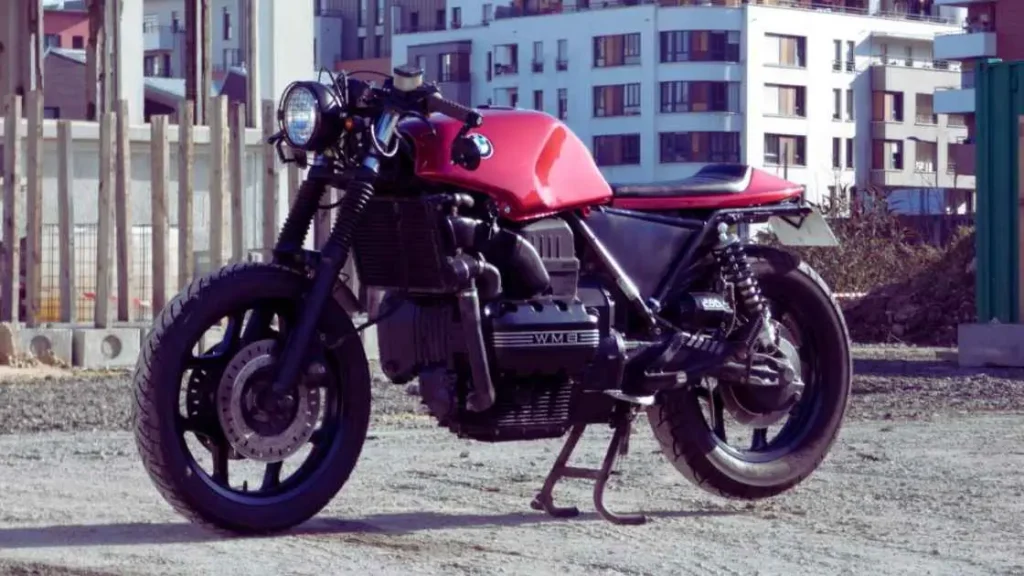
The bike has a liquid-cooled engine, giving it a smooth ride. Its simple design makes it easy to turn into a cafe racer. It combines old style with modern power. The K75 is built to last and is easy to customize.
In this guide, I’ll show you how to turn your BMW K75 into a custom cafe racer that looks amazing and rides even better.
Step 1: Planning Your BMW K75 Cafe Racer Build
So, you have a BMW K75 and want to turn it into a cafe racer. Before you grab your tools and start cutting, let’s take a moment to plan your BMW K75 cafe racer build. Trust me, this step will save you a lot of trouble later.
Set Your Goals
What do you want from your cafe racer build? Maybe you want a bike that handles great on curvy roads, or perhaps you’re after that classic, minimalist cafe racer aesthetic. Whatever your goal, be clear about it. Defining your vision will guide the design, performance, and budget of your BMW K75 cafe racer build.
- Style: Do you want a stripped-down, bare look? Or are you aiming for a modern design with LED lights and tech features? Write down your ideas, sketch them out, or create a mood board to help you plan your dream cafe racer.
- Performance: Will your BMW K75 cafe racer be used for daily rides or just weekends? This decision will influence whether you need comfort upgrades or performance enhancements like improved suspension or engine tuning.
Create a Budget
Building a BMW K75 cafe racer can cost a lot or a little, depending on your choices. But let’s be honest—costs can add up quickly. From buying new parts to custom work, expenses can get high if you don’t set a clear budget from the start for your BMW K75 cafe racer build.
Here’s a basic breakdown of potential expenses for a BMW K75 cafe racer build:
- Donor bike (in this case, your BMW K75): $2,000 – $5,000
- Aftermarket parts (seats, handlebars, lights): $500 – $3,000
- Mechanical upgrades (engine tuning, suspension): $1,000 – $4,000
- Paint and finishing: $300 – $1,500
Gather Tools and Equipment
Before you start working on your BMW K75 cafe racer build, ensure you have the right tools. Depending on your specific build, you may need basic tools as well as some specialized equipment. Here’s a simple checklist to help you get started:
- Wrenches and ratchet sets
- Torque wrench (for precise tightening)
- Screwdrivers (both Phillips and flathead)
- Angle grinder (for frame modification)
- Welder (if you’re working on the frame or exhaust)
- Multimeter (for electrical work)
Having the right tools will not only make your BMW K75 cafe racer build smoother, but it will also help you avoid damaging the bike or aftermarket parts.
Step 2: Tearing Down the BMW K75 for Your Cafe Racer Build
This is where the fun begins. The first step in your BMW K75 cafe racer build is to strip the bike down to its essential components. Don’t worry—you won’t be stuck with a pile of parts forever. This is just the beginning of transforming your BMW K75 into a custom cafe racer.

Remove Unnecessary Parts
The cafe racer aesthetic is all about simplicity, and that means saying goodbye to many of the bulky stock parts that the BMW K75 comes with. Here’s a list of things you’ll likely want to remove as part of your BMW K75 cafe racer build:
- Fairings and luggage racks: If your bike came with any of these, they’re the first to go.
- Stock seat: The factory seat is bulky and doesn’t fit the cafe racer vibe. You’ll replace this later with something slimmer and more minimalistic.
- Handlebars: The stock handlebars are too high and wide for a true cafe racer. You’ll be swapping these for clip-ons or clubman bars.
- Exhaust: You’ll be upgrading this for both performance and style.
Take your time during this teardown process. Label parts, take photos, and keep track of everything you remove. Even though you’re going for a minimal look, some of these parts will need to be replaced or modified for your BMW K75 cafe racer build.
Step 3: Essential Modifications for a BMW K75 Cafe Racer
Alright, your BMW K75 is taken apart and ready to go. Now comes the big part of turning that bike into a custom cafe racer. This is where you’ll make changes that give your BMW K75 cafe racer build its distinct look.
Frame Modifications
One of the most important aspects of a BMW K75 cafe racer build is modifying the frame. While the BMW K75 frame is strong, it’s not as sleek as it could be. A cafe racer needs to look clean and lightweight, so you’ll want to shorten the subframe. This gives the bike that sharp, simple tail that cafe racers are known for.
Before cutting the frame, ensure you know what you’re doing. Measure twice, cut once. You’ll need to cut the back of the subframe and smooth the welds to make it look neat. If you plan on carrying extra weight or a passenger, reinforcing the frame is also essential for safety and performance.
Upgrading the Suspension
The stock suspension on a BMW K75 is designed for comfort, but it may not provide the sharp, responsive feel you’re after for a cafe racer build. That’s why many builders upgrade both the front forks and rear shocks.
For the front, a popular modification is swapping in modern forks from sportbikes like the Honda CBR. These offer better control and adjustability, improving handling and giving the bike a more aggressive look—perfect for a BMW K75 cafe racer build.
For the rear, aftermarket shocks are essential. Look for adjustable shocks that handle both city riding and backroad adventures. Brands like Ohlins or Progressive Suspension are great for top-tier performance.
Clip-On Handlebars and Controls
The handlebars are a key component in how your BMW K75 cafe racer feels to ride. Swap the stock handlebars for something lower, like clip-ons or clubman bars, which will lower your riding position for a more aggressive cafe racer look.
Installing clip-ons is relatively straightforward, though you may need to adjust the forks or triple tree. While you’re at it, upgrade the grips and controls. The stock grips on the BMW K75 work fine but don’t match the vintage cafe racer aesthetic. Opt for leather or rubber vintage-style grips for the perfect finish.
Additionally, many builders replace the stock switches and levers. Sleeker, modern controls not only look great but also improve functionality.
Exhaust and Engine Upgrades
One of the most rewarding upgrades in any BMW K75 cafe racer build is the exhaust. The stock BMW K75 exhaust works but doesn’t offer the deep sound or sleek look you want in a cafe racer. A custom exhaust improves both performance and style.
A popular choice is a short exhaust that highlights the rear wheel and cleans up the overall look. Not only will a new exhaust sound better, but it will also boost performance by lowering backpressure. You can opt for a 2-into-1 setup or a high-mount pipe for a tougher aesthetic. Brands like Toce or custom fabricators can help you achieve the right sound and look for your BMW K75 cafe racer build.
While upgrading the exhaust, consider making engine improvements as well. The K75’s three-cylinder engine is already solid, but a high-flow air filter or a custom fuel map can enhance performance.
Wiring the Bike
Wiring is where many first-time builders get stuck, but it’s crucial to your BMW K75 cafe racer build. The BMW K75 has a complex electrical system, so simplifying it is a good idea. Consider using a BEP 3.0 module or an Arduino-based system to replace the stock electronics. These systems make it easier to add parts like LED lights or a custom speedometer.
Hide as much of the wiring as possible to keep the bike looking clean. You may need to relocate the battery and other electrical components to a custom box under the seat or tank.
For lighting, many builders opt for retro-style LED headlights with a grill for a vintage look. Adding an LED strip for the tail light and incorporating modern turn signals gives the bike a contemporary touch while maintaining that classic cafe racer vibe.
Cafe Racer Seat and Tail Design
Upgrading the seat is one of the best ways to change the look of your BMW K75 cafe racer. Typically, a cafe racer seat is shorter and slimmer than the stock seat on a BMW K75. You can buy a pre-made cafe racer seat or craft your own. Many builders choose a single seat with a rear cowl for a clean, classic finish.
It’s important to match the seat design to the bike’s overall lines. The seat and rear cowl should flow smoothly with the tank and frame, creating a cohesive look. Consider using materials like leather or suede for the seat cover. Make sure to add padding if you plan on riding for extended periods.
Step 4: Electrical System Overhaul
Now that we’ve discussed the major changes for your BMW K75 cafe racer build, let’s talk about the electrical system. Even experienced builders find this part daunting, but wiring is crucial. A clean, organized electrical setup will make your BMW K75 not only reliable but also aesthetically pleasing.
Simplifying the Wiring
One of the first tasks in your BMW K75 cafe racer build should be simplifying the wiring. The BMW K75’s old wiring can be tricky, especially if you’re new to bike building. To make it easier, many builders use a BEP 3.0 module or similar system. This replaces much of the old wiring, making the job simpler and more efficient.
These modules combine multiple functions (like lights, indicators, and the starter) into one unit. This reduces excess wiring and makes future repairs or modifications much easier in your BMW K75 cafe racer build.
Upgrading to LED Lighting
While traditional cafe racers have simple, old-style lights, upgrading to LED lighting can modernize your BMW K75 cafe racer build while maintaining its classic feel. For the headlight, consider a 7-inch LED with a retro grille or halo ring. This option offers a vintage look while improving visibility and saving energy. LED lights use less power than standard bulbs, extending the life of your electrical system, especially if you’re using a smaller battery.
Battery Relocation
To achieve that minimalist cafe racer look, it’s essential to hide the electronics, especially the battery. The stock BMW K75 battery is quite large and prominent. To clean up the bike’s appearance, consider relocating the battery to a hidden spot.
A smaller lithium-ion battery is an excellent choice. It’s lighter and more compact than the standard battery, allowing you to tuck it under the seat, in a custom box, or beneath the gas tank. This not only improves the look of your BMW K75 cafe racer build but also helps balance the bike’s weight distribution.
Adding a Custom Speedometer and Instrumentation
Don’t forget about the gauges. The stock BMW K75 instrument cluster is bulky and doesn’t align with the sleek cafe racer aesthetic. Fortunately, there are many modern, slim options available. A digital speedometer or a small analog gauge will clean up the bike’s front end, enhancing the overall look.
Many riders choose a Motogadget unit, which is widely popular for custom cafe racers. These compact, fully digital units integrate seamlessly with your simplified wiring, making installation straightforward for your BMW K75 cafe racer build.
Step 5: Cafe Racer Aesthetics – Designing the Look
Now that you’ve completed the wiring and mechanics, it’s time for the exciting part: designing your BMW K75 cafe racer. The look of the bike is what sets it apart. Simple lines, custom paint, and minimal parts will help your BMW K75 cafe racer build stand out.
Choosing the Right Paint Scheme
One of the most important decisions you’ll make for your BMW K75 cafe racer build is selecting the paint. The color of your bike can drastically affect how it looks and feels. Traditional cafe racers often feature simple colors like black, silver, green, or blue. However, you can choose bright colors to give your bike a unique flair.
Some builders prefer the raw look of a metal tank, which gives the bike a rugged, industrial feel. You can apply a clear coat to the metal to prevent rust while keeping its natural look visible. If you opt for a custom paint job, be sure to use high-quality paint that will endure various weather conditions.
Custom Seat and Tail Design
Every cafe racer needs a simple, custom seat and tail section. The stock seat on the BMW K75 is too large for the typical cafe racer aesthetic, so replacing it with a slimmer, single-seat design is a popular choice. Many builders opt for leather seats for that classic, timeless look.
You’ll also need to decide whether to include a rear cowl. You can fabricate one from metal or buy a pre-made option. The rear cowl should match the seat and tank, giving the bike a seamless line from front to back, which is essential for a sleek BMW K75 cafe racer build.
Finishing Touches: Mirrors, Grips, and Small Details
Now let’s focus on the finishing touches that will make your BMW K75 cafe racer truly stand out. These small details include mirrors, grips, and footpegs. Choose simple mirrors that don’t protrude too much—bar-end mirrors are a great option because they keep the handlebars tidy and functional.
For grips, leather or rubber options are popular choices for a classic look. Don’t forget to upgrade the footpegs as well; stock pegs can look bulky. New, streamlined footpegs not only enhance the appearance but also provide a more sporty feel during rides.
These little details may seem minor, but they’re crucial in turning your BMW K75 cafe racer build from a basic project into a fully custom, show-stopping bike.
Step 6: Final Adjustments and Testing
The hard work is done. Your BMW K75 cafe racer looks fantastic, with the wiring hidden and new custom parts installed. But before you hit the road, there are a few more steps to ensure your bike is not only stylish but also safe and ready to ride.
Adjusting the Ergonomics
Let’s talk about how your BMW K75 cafe racer feels when you ride. After making modifications, it’s crucial to ensure your riding position is comfortable and matches the cafe racer style. Adjusting the handlebars, footpegs, and seat height is essential for finding the right position.
If you added rearsets, you might need to fine-tune them to suit your body size. While cafe racers often have a forward-leaning stance, you should find a balance between style and comfort—you don’t want to feel uncomfortable after just 10 minutes of riding!
Here’s a quick checklist to make sure everything feels right:
- Handlebar height: Are your handlebars positioned comfortably for your wrists and shoulders?
- Footpeg position: Do the footpegs align with your natural leg position?
- Seat height: Is the seat height comfortable, allowing easy access to controls?
Test Ride and Fine-Tuning
Now comes the most exciting part—testing your new BMW K75 cafe racer! However, before you ride, let’s talk about safety. After major modifications, such as changes to the frame or suspension, you need to ensure everything is solid and secure.
Start with a slow ride around the block. Listen for unusual sounds, feel for vibrations, and observe how the bike handles. Pay attention to the suspension, acceleration, and braking. Here’s a checklist for your first test ride:
- Handling and suspension: Is the bike responding as expected? If the suspension feels too soft or too stiff, adjust it accordingly.
- Braking: Are the brakes performing well with your new, lighter bike? If you installed new brake components, ensure they are functioning correctly.
- Wiring and electronics: Check that the lights, indicators, and instruments are working properly. Double-check that no connections came loose during the ride.
It’s wise to carry basic tools with you for quick adjustments. Keep in mind that it’s normal for a build to require some fine-tuning after the first ride.
Common Challenges and How to Overcome Them
Every bike build has its challenges, and your BMW K75 cafe racer build is no exception. Don’t worry—overcoming these obstacles will make the end result even more rewarding. Here are some common issues you might face and tips for resolving them:
- Wiring problems: Wiring can be a headache for cafe racer builders. If you’re struggling, consider using a pre-made wiring harness or a simplified control unit like the BEP 3.0 module. This can make wiring easier and help with future repairs.
- Exhaust clearance: After installing a custom exhaust, you might encounter clearance issues with the frame or rear wheel. Adjusting the exhaust brackets or choosing a different path for the exhaust can resolve this without compromising the bike’s style or performance.
- Seat comfort: While cafe racer seats often prioritize looks over comfort, you don’t have to sacrifice one for the other. If the seat feels too hard, consider adding a gel insert or using firmer foam to improve comfort on longer rides.
Your BMW K75 cafe racer is finally complete, so take a moment to appreciate your accomplishment. It’s more than just a bike—it’s a reflection of your creativity, hard work, and personal style. Every time you ride, you’ll be reminded of the effort and passion you put into your BMW K75 cafe racer build, and that feeling never gets old.
A cafe racer isn’t just fun to ride; it’s a conversation starter. Whether you’re riding around town or attending an event, people will notice and compliment your bike.
But remember, a cafe racer build is never truly finished. Even after it’s complete, there will always be upgrades, changes, and new ideas to explore. That’s part of the fun. A BMW K75 cafe racer is more than just a motorcycle—it’s an evolving project that continues to grow and change.
So, enjoy the ride, but also enjoy the ongoing process of building, learning, and trying new things. You’ve transformed a classic BMW K75 into something unique, blending cafe racer style with the bike’s inherent reliability.
Final Thoughts
Building a BMW K75 cafe racer is a special experience, whether it’s your first build or not. It requires hard work, but every step—from planning to the first ride—is worth the effort. Each moment brings you closer to creating something truly special.
A cafe racer is more than just about looks—it’s about the ride, the mechanics, and the passion behind the build. It’s about stripping away what you don’t need and focusing on the pure joy of riding.
Now it’s your turn. Grab your tools, make a plan, and begin your own BMW K75 cafe racer build. The possibilities are endless, and the journey ahead will be just as rewarding as the final product.
FAQs
Why is the BMW K75 a good bike for making a cafe racer?
The BMW K75 is great for building a cafe racer. It has a strong engine called the “Flying Brick.” It’s known for working well and not being too expensive. Its engine runs smoothly and it’s easy to change its look. This makes the K75 perfect for both new and expert builders.
What should I do first when building my BMW K75 cafe racer?
Before you start, plan well. Decide what you want your bike to look like and how you want it to run. Make a budget so you know how much you can spend on the bike and parts. Get all the tools you need, like wrenches, screwdrivers, a grinder, and maybe a welder and a tool to measure electricity.
What are the big changes needed for a BMW K75 cafe racer?
For a BMW K75 cafe racer, you need to change the frame to make it look sleek and light. You should get better forks and shocks for smoother rides. Change the handlebars for a sporty look and add a new exhaust for better performance and style.
How do I handle the wiring and electrical changes in my BMW K75 cafe racer?
Keep the wiring simple. Use a control unit like the BEP 3.0 to help with this. Put the battery in a hidden spot and choose a small, light one. Use LED lights because they work better and look modern. Think about a small digital speedometer too.
What are some common problems when building a BMW K75 cafe racer and how can I fix them?
You might find the wiring tricky, have trouble with how the exhaust fits, or struggle with making the seat both comfy and cool. For wiring, use a simpler setup. For exhaust issues, adjust the mounts or move the pipes. For a comfy seat, try a gel insert or firmer foam.
What do I do after I finish my BMW K75 cafe racer?
Test your bike carefully to make sure it’s safe and works well. Adjust it to be comfy for you. Take it for a ride to see how it feels and works. Be ready to make changes if needed. Then, enjoy your bike and think about updates you might want later.

